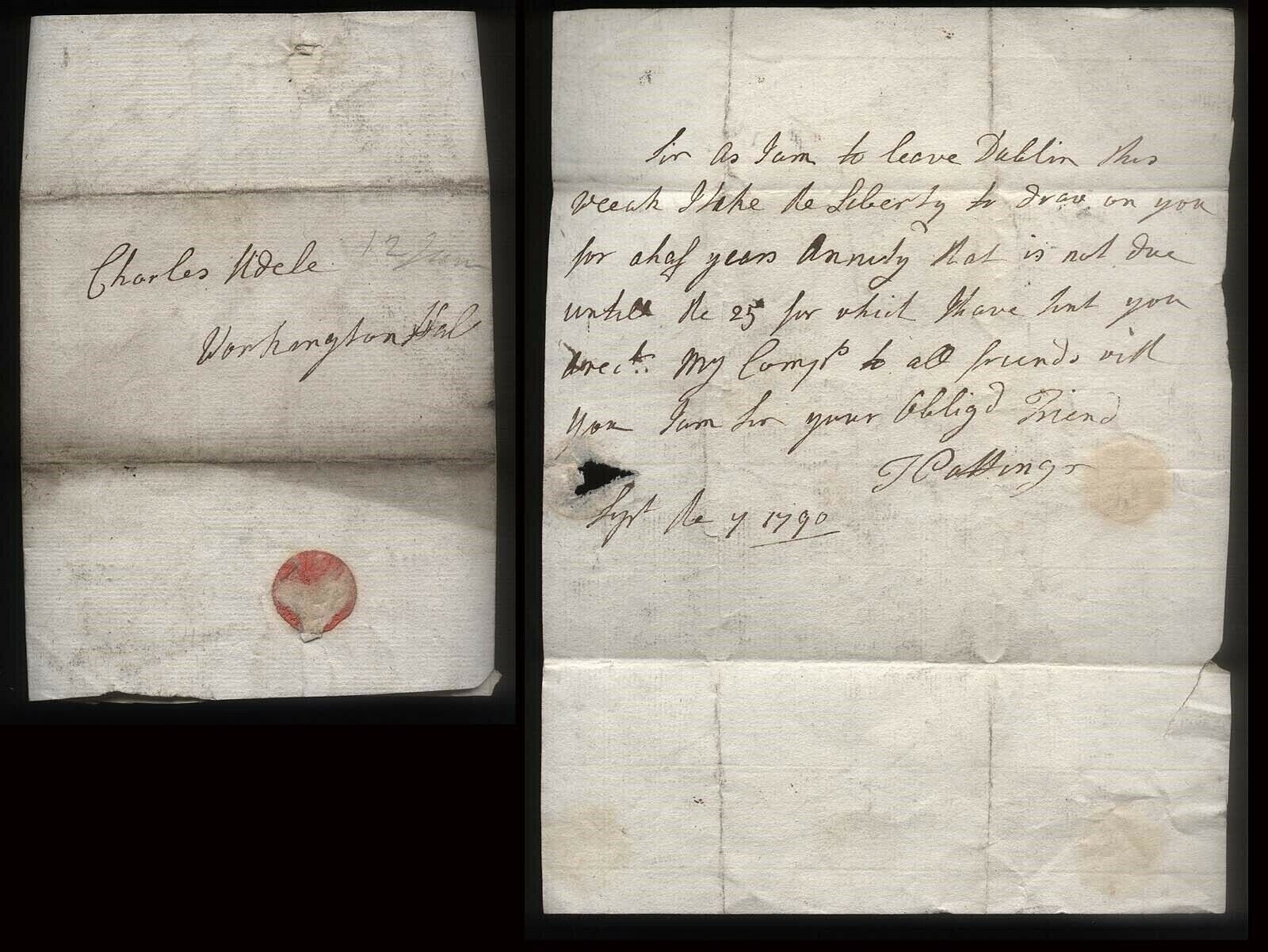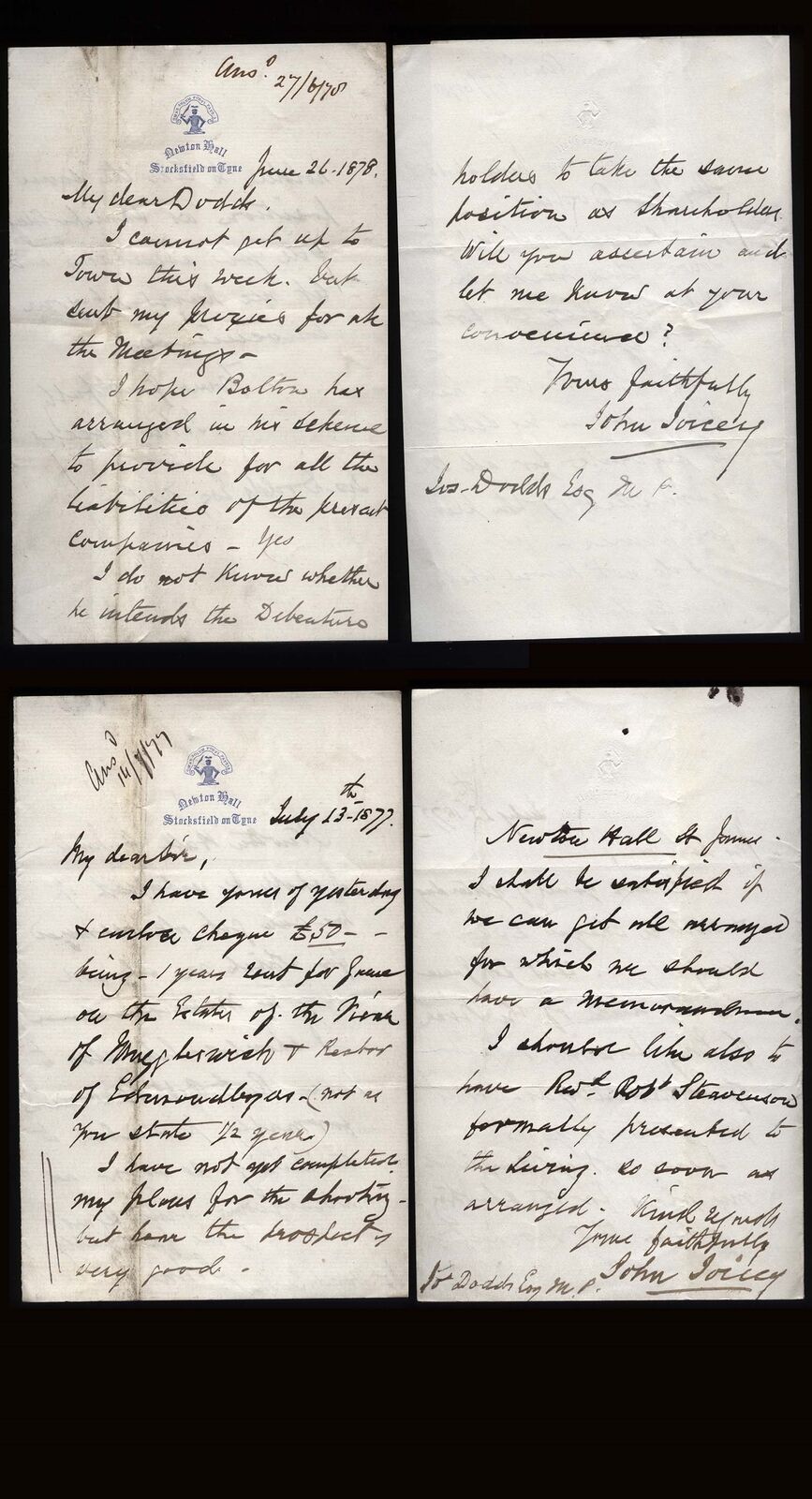-40%
1845 THOMAS BELL famous Newcastle Surveyor, Letter re ALNWICK PLANS
$ 19.19
- Description
- Size Guide
Description
1845 THOMAS BELL famous Newcastle Surveyor, Letter re ALNWICK PLANSThis product data sheet is originally written in English.
Four generations of the Bell family were involved in land surveying, but it was not until around 1844 that the company name makes an appearance in trades directories and on plans produced by members of the family. Prior to this date individual family members are listed separately in directories, although they clearly did work together, as the records show.
The founder of the firm was John Bell the elder, son of Richard Bell of High Park, Northumberland. He was apprenticed at the age of 15 (c1770) to John Fryer, land surveyor and mathematician, However, John Bell did not remain long with Fryer and he went to work instead for Solomon
Hodgson
, a printer and bookseller in Union Street, Newcastle. He evidently did not give up surveying entirely, because, although he took over the stationery and
bookselling
areas of
Hodgson's
business in 1794, he continued to be listed in contemporary trades directories as a land surveyor in Westmorland Street, Newcastle. Amongst his other activities he was valuer and surveyor to the Duke of Northumberland. He lived at Bell's Court,
Newgate
Street . John Bell died in 1816, in middle of enclosure of buried N/
CST
John.
John
Bell's two eldest sons, John Bell the younger and
Thomas Bell
were also trained as surveyors and booksellers, and assisted their father in his businesses. From 1805, the bookselling business traded as John Bell and Sons.
John Bell the younger, the eldest son, opened his own bookshop on Newcastle Quayside, C 1803. He was also a renowned collector of coins, antiquities and rate books and himself published collections of local tracts. Biographies of John Bell the younger speak in 1816/17 of a "disarrangement of his private affairs" which led to the abandonment of his Quayside shop. The baptismal entries of his children in the parish registers of Newcastle, St John at this period describe him as "Of Newgate Street, Stationer" until at least 1817, but by 1822 he is described as "Of Windmill Hills, Gateshead, land surveyor" What the disarrangement was is not stated, but it may have been connected with his father's death. John Bell was the founder of the Antiquarian Society of Newcastle and remained a collector of antiquarian printed material all his life.
From the early 1820's John Bell operated from Gateshead, firstly at Borough Bar Houses, Windmill Hills, but from about 1838, at 104/5 High Street. His two eldest sons John Thomas William Bell and George Grey Bell followed in the family business. John T.W. Bell is listed in a directory of 1847 as a civil engineer and land surveyor at 20 Sandhill, Newcastle, and George Grey Bell at is listed in Wards directory of 1861/2 as a land and mine surveyor at 2 Hardwicke Terrace, Gateshead.
Thomas Bell
,
after whom the firm is named, (second son of John Bell the elder) reputedly began assisting his father in surveying before he was 15, and it was the rather than his elder brother who took over his father's businesses at his death - half way through the Enclosure of Gateshead Town Fields! He also maintained the bookselling and stationery business until his own sons, William John Bell and John Grey Bell were old enough to take it on. His offices were at 17, Union Street, Newcastle until the mid 1820's when he moved his surveying office to 25-27, Great Market, Newcastle. His principal assistant was his eldest son, Thomas George Bell, but several of his other sons also assisted him at various times, as their names or initials are found as plans, or they are listed in directories as surveyors. They were William John, Christopher Seymour, John Grey, Septimus and Decimus Bell of these only Christopher Seymour Bell seems to have pursued surveying as a career full-time, and it was he who took over the business when his father died in 1860
Thomas like his brother John was an avoid collector of local literature which he systematically divided into subject areas, wrote notes about and then bound up. After his death his book collection (some 15,000 volumes) was sold off. So very few examples of his collected literature exist in this collection several hundred were donated to the Newcastle Society of Antiquanes but the remainder were dispersed.
Thomas also succeeded his father as valuer and surveyor to the Duke of Northumberland.
His other major clients were the Earl of Strathmore and the Newcastle and Carlisle Railway Company. He appointed Commissioner for many throughout the North of England.
Thomas had several residences throughout his lifetime, but most of his adult life was spent at 16, Cumberland Row, Newcastle
As stated earlier, Thomas changed the name of his business to Thomas Bell and Sons c 1844 and it continued under this title until c 1862 when it ceases to appear in trades directories. After this date, Christopher Seymour Bell traded under his own name, and Thomas other sons seem to have gone their separate ways
:
Powered by SixBit's eCommerce Solution
Four generations of the Bell family were involved in land surveying, but it was not until around 1844 that the company name makes an appearance in trades directories and on plans produced by members of the family. Prior to this date individual family members are listed separately in directories, although they clearly did work together, as the records show.The founder of the firm was John Bell the elder, son of Richard Bell of High Park, Northumberland. He was apprenticed at the age of 15 (c1770) to John Fryer, land surveyor and mathematician, However, John Bell did not remain long with Fryer and he went to work instead for Solomon Hodgson, a printer and bookseller in Union Street, Newcastle. He evidently did not give up surveying entirely, because, although he took over the stationery and
Related Interests
Alnwick Plan
EAN
Does Not apply
Country
England
Family Surname
Bell
City/Town/Village/Place
Newcastle
England County
Northumberland
Era
1845
Document Type
Manuscript Letter








